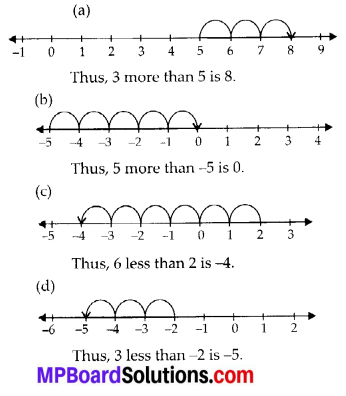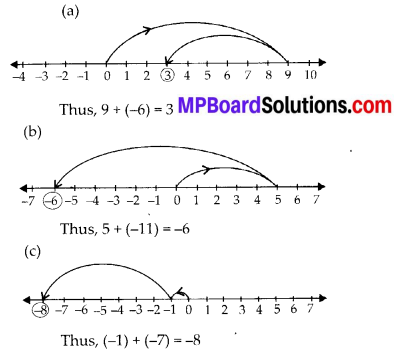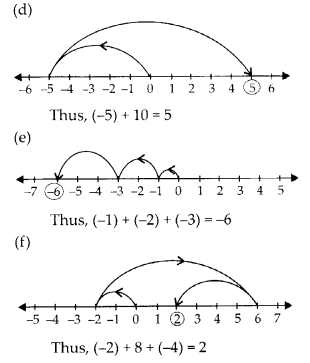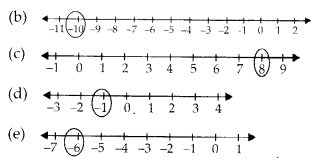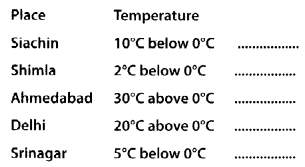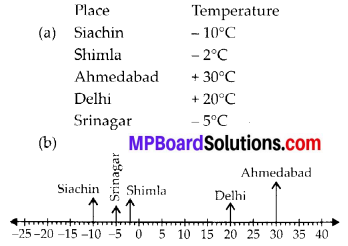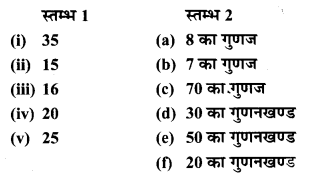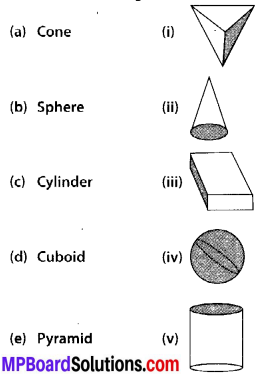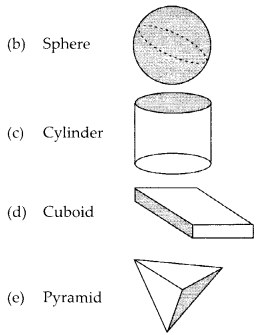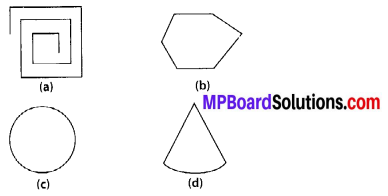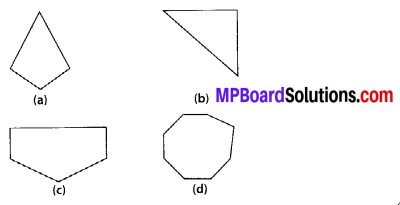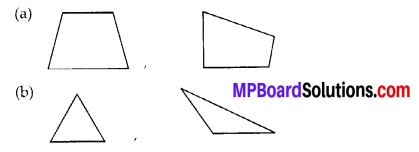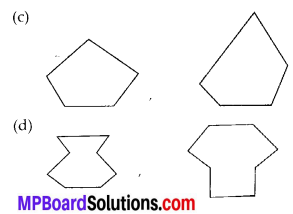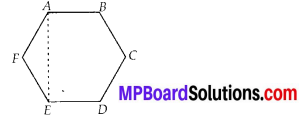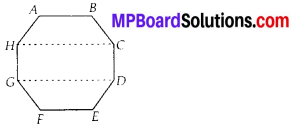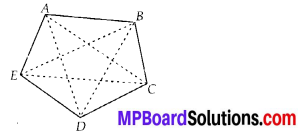MP Board Class 6th Maths Solutions Chapter 3 संख्याओं के साथ खेलना Ex 3.3
प्रश्न 1.
विभाज्यता की जाँच के नियमों का प्रयोग करते हुए, पता कीजिए कि निम्नलिखित संख्याओं में से कौन-सी संख्याएँ 2 से विभाज्य हैं; 3 से विभाज्य हैं; 4 से विभाज्य हैं; 5 से विभाज्य है; 6 से विभाज्य हैं; 8 से विभाज्य है; 9 से विभाज्य हैं; 10 से विभाज्य हैं या 11 से विभाज्य हैं (हाँ या नहीं कहिए):
हल :

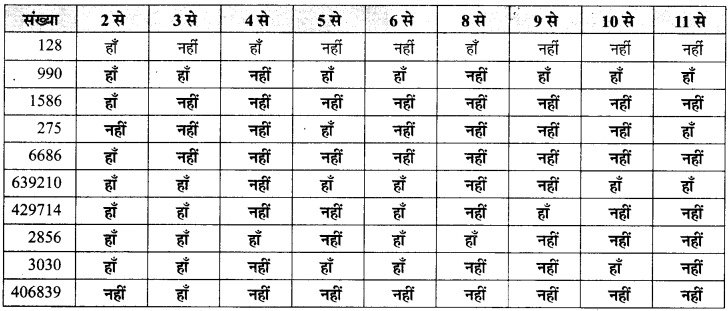
प्रश्न 2.
विभाज्यता की जाँच के नियमों द्वारा ज्ञात कीजिए कि निम्नलिखित में से कौन-सी संख्याएँ 4 से विभाज्य हैं और कौन-सी 8 से विभाज्य हैं :
(a) 572
(b) 726352
(c) 5500
(d) 6000
(e) 12159
(f) 14560
(g) 21084
(h) 31795072
(i) 1700
(j) 2150
हल :
4 से विभाज्यता-यदि किसी संख्या के दहाई और इकाई के अंकों से बनी संख्या 4 से विभाज्य है, तो वह संख्या 4 से विभाज्य होगी।
(a) 572 में 72, 4 से विभाज्य है। अत: 572, 4 से विभाज्य है।
(b) 726352 में 52, 4 से विभाज्य है। अत: 726352, 4 से विभाज्य है।
(c) 5500 में 00, 4 से विभाज्य है। अतः 5500, 4 से विभाज्य है।
(d) 6000 में 00, 4 से विभाज्य है। अत: 6000, 4 से विभाज्य है।
(e) 12159 में 59, 4 से विभाज्य नहीं है। अत: 12159, 4 से विभाज्य नहीं है।
(f) 14560 में 60, 4 से विभाज्य है। अतः 14560, 4 से विभाज्य है।
(g) 21084 में 84, 4 से विभाज्य है। अत: 21084, 4 से विभाज्य है।
(h) 31795072 में 72, 4 से विभाज्य है। अतः 31795072, 4 से विभाज्य है।
(i) 1700 में 00, 4 से विभाज्य है। अतः 1700, 4 से विभाज्य है।
(j) 2150 में 50, 4 से विभाज्य है। अतः 2150, 4 से विभाज्य है।
8 से विभाज्यता – यदि किसी संख्या के सैकड़े, दहाई व इकाई के अंकों से बनी संख्या 8 से विभाज्य है तो वह संख्या 8 से विभाज्य होगी।
(a) 572 में 572, 8 से विभाज्य नहीं है। अतः 572, 8 से विभाज्य नहीं है।
(b) 726352 में 352, 8 से विभाज्य है। अतः 726352, 8 से विभाज्य है।
(c) 5500 में 500, 8 से विभाज्य नहीं है। अतः 5500, 8 से विभाज्य नहीं है।
(d) 6000 में 000, 8 से विभाज्य है। अतः 6000, 8 से विभाज्य है।
(e) 12159 में 159, 8 से विभाज्य नहीं है। अत: 12159, 8 से विभाज्य नहीं है।
(f) 14560 में 560, 8 से विभाज्य है। अतः 14560, 8 से विभाज्य है।
(g)21084 में 084,8 से विभाज्य नहीं है। अत: 21084, 8 से विभाज्य नहीं है।
(h) 31795072 में 072, 8 से विभाज्य है। अतः 31795072, 8 से विभाज्य है।
(i) 1700 में 700, 8 से विभाज्य नहीं है। अतः 1700, 8 से विभाज्य नहीं है।
(j) 2150 में 150, 8 से विभाज्य नहीं है। अत: 2150, 8 से विभाज्य नहीं है।
![]()
प्रश्न 3.
विभाज्यता की जाँच के नियमों द्वारा ज्ञात कीजिए कि निम्नलिखित में से कौन-सी संख्याएँ 6 से विभाज्य हैं:
(a) 297144
(b) 1258
(c) 4335
(d) 61233
(e) 901352
(f) 438750
(g) 1790184
(h) 12583
(i) 639210
(j) 17852
हल :
कोई भी संख्या 6 से विभाज्य होती है यदि वह 2 और 3 से विभाज्य हो।
(a) संख्या 297144 में इकाई का अंक 4 है इसलिए यह 2 से विभाज्य है।
इसके अंकों का योग = 2 + 9 + 7 + 1 + 4 + 4 + 4 = 27 जो कि 3 से विभाज्य है।
∴297144, 6 से विभाज्य है।
(b) संख्या 1258 में इकाई का अंक 8 है। इसलिए यह 2 से विभाज्य है।
इसके अंकों का योग = 1 + 2 + 5 + 8 = 16 जो कि 3 से विभाज्य नहीं है।
∴1258, 6 से विभाज्य नहीं है।
(c) संख्या 4335 में इकाई का अंक 5 है। इसलिए यह 2 से विभाज्य नहीं है।
∴4335, 6 से भी विभाज्य नहीं है।
(d) संख्या 61233 में इकाई का अंक 3 है। इसलिए यह 2 से विभाज्य नहीं है।
∴61233, 6 से भी विभाज्य नहीं है।
(e) संख्या 901352 में इकाई का अंक 2 है। इसलिए यह 2 से विभाज्य है।
इसके अंकों का योग = 9 + 0 + 1 + 3 + 5 + 2 = 20 जो कि 3 से विभाज्य नहीं है।
∴901352, 6 से विभाज्य नहीं है।
(f) संख्या 438750 में इकाई का अंक 0 है। इसलिए यह 2 से विभाज्य है।
इसके अंकों का योग = 4 + 3 + 8 + 7 + 5 + 0 = 27 जो कि 3 से विभाज्य है।
∴438750, 6 से विभाज्य है।
(g) संख्या 1790184 में इकाई का अंक 4 है। इसलिए यह 2 से विभाज्य है।
इसके अंकों का योग = 1 + 7 + 9 + 0 + 1 + 8 + 4 = 30 जो कि 3 से विभाज्य है।
∴1790184, 6 से विभाज्य है।
(h) संख्या 12583 में इकाई का अंक 3 है। इसलिए यह 2 से विभाज्य नहीं है।
∴12583, 6 से विभाज्य नहीं है।
(i) संख्या 639210 में इकाई का अंक शून्य है। इसलिए यह 2 से विभाज्य है।
इसके अंकों का योग = 6 + 3 + 9 + 2 + 1 + 0 = 21, जोकि 3 से विभाज्य है।
∴639210, 6 से विभाज्य है।
(j) संख्या 17852 से इकाई का अंक 2 है। इसलिए यह 2 से विभाज्य है।
इसके अंकों का योग = 1 + 7 + 8 + 5 + 2 = 23 जो कि 3 से विभाज्य नहीं है।
∴17852, 6 से विभाज्य नहीं है।
प्रश्न 4.
विभाज्यता की जाँच के नियमों द्वारा ज्ञात कीजिए कि निम्नलिखित में से कौन-सी संख्याएँ 11 से विभाज्य हैं :
(a) 5445
(b) 10824
(c) 7138965
(d) 70169308
(e) 10000001
(f) 901153
हल :
किसी संख्या के दायें से विषम स्थानों के अंकों का योग और सम स्थानों के अंकों का योग का अन्तर 0 हो या 11 से विभाज्य हो, तो वह संख्या 11 से विभाज्य होगी।
(a) संख्या 5445
दायें से, विषम स्थानों के अंकों का योग = 5 + 4 = 9
सम स्थानों के अंकों का योग = 4 + 5 = 9
∵अंकों के योग का अन्तर = 9 – 9 = 0
∴5445, 11 से विभाज्य है।
(b) संख्या 10824
दायें से, विषम स्थानों के अंकों का योग
= 4 + 8 + 1 = 13
सम स्थानों के अंकों का योग = 2 + 0 = 2
∴इन दोनों योगों का अन्तर = 13 – 2 = 11
जो कि, 11 का गुणज है।
∴10824, 11 से विभाज्य है।
(c) संख्या 7138965
दायें से, विषम स्थानों के अंकों का योग
= 5 + 9 + 3 + 7 = 24
सम स्थानों के अंकों का योग = 6 + 8 + 1 = 15
∴इन दोनों योगों का अन्तर = 24 – 15 = 9
जो कि 11 का गुणज नहीं है।
∴7138965, 11 से विभाज्य नहीं है।
(d) संख्या 70169308 दायें से, विषम स्थानों के अंकों का योग
= 8 + 3 + 6 + 0 = 17
सम स्थानों के अंकों का योग = 0 + 9 + 1 + 7 = 17
∴इन दोनों योगों का अन्तर = 17 – 17 = 0
∴70169308, 11 से विभाज्य है।
(e) संख्या 10000001 दायें से विषम स्थानों के अंकों का योग
= 1 + 0 + 0 + 0 = 1
सम स्थानों के अंकों का योग = 0 + 0 + 0 + 1 = 1
∴इन दोनों योगों का अन्तर = 1 – 1 = 0
∴10000001, 11 से विभाज्य है।
(f) संख्या 901153
दायें से, विषम स्थानों के अंकों का योग
= 3 + 1 + 0 = 4
समस्थानों के अंकों का योग = 5 + 1 + 9 = 15
∴इन दोनों योगों का अन्तर = 15 – 4 = 11
जो कि 11 का गुणज है।
∴901153, 11 से विभाज्य है।
![]()
प्रश्न 5.
निम्नलिखित में रिक्त स्थानों में सबसे छोटा अंक तथा सबसे बड़ा अंक लिखिए, जिससे संख्या 3 से विभाज्य हो :
(a)….. 6724
(b) 4765 …..2
हल :
यदि किसी संख्या के अंकों का योग 3 से विभाज्य है तो वह संख्या 3 से विभाज्य होगी।
(a)…… 6724 के अंकों का योग = 6 + 7 + 2 + 4 = 19
यदि इसमें 2 जोड़ दें तो 21 प्राप्त होगा जो कि 3 से विभाज्य है।
यदि इसमें 8 जोड़ दें तो 27 प्राप्त होगा जो कि 3 से विभाज्य है।
∴सबसे छोटा अंक 2 और सबसे बड़ा अंक 8 है।
(b) 4765……2 के अंकों का योग = 4 + 7 + 6 + 5 + 2 = 24
जो कि 3 से विभाज्य है। इसलिए सबसे छोटा अंक 0 है।
यदि 24 में 9 जोड़ दें तो 33 आएगा जो कि 3 से विभाज्य है।
∴सबसे छोटा अंक 0 और सबसे बड़ा अंक 9 है। उत्तर
प्रश्न 6.
निम्नलिखित में रिक्त स्थानों में ऐसा अंक लिखिए, ताकि संख्या 11 से विभाज्य हो :
(a) 92 – 389
(b) 8 – 9484
हल :
(a) 92 – 389 में, दायें से
विषम स्थानों के अंकों का योग = 9 + 3 + 2 = 14
सम स्थानों के अंकों का योग = 8 + अभीष्ट अंक + 9
= 17 + अभीष्ट अंक
इन दोनों योगों का अन्तर = अभीष्ट अंक + 17 -14
= अभीष्ट अंक + 3
∵यह संख्या 11 का गुणज होनी चाहिए
∴अभीष्ट अंक + 3 = 11
अभीष्ट अंक = 11 – 3 = 8
(b) 8 – 9484 में, दायें से
विषम स्थानों के अंकों का योग = 4 + 4 + अभीष्ट अंक
= 8 + अभीष्ट अंक
सम स्थानों के अंकों का योग = 8 + 9 + 8 = 25
इन दोनों योगों का अन्तर = 25 – (8 + अभीष्ट अंक)
= 17 – अभीष्ट अंक
∴यह संख्या 11 का गुणज होनी चाहिए।
∴17 – अभीष्ट अंक = 11
अत : अभीष्ट अंक = 17 – 11 = 6
पाठ्य-पुस्तक पृष्ठ संख्या # 62
प्रयास कीजिए
प्रश्न a.
निम्न युग्मों के उभयनिष्ठ या सार्व गुणनखण्ड क्या हैं ?
(a) 8, 20
(b) 9, 15
हल :
(a) 8 = 1 x 8, 8 = 2 x 4
∴8 के गुणनखण्ड = 1, 2, 4 और 8 …(1)
पुनः 20 = 1 x 20, 20 = 2 x 10, 20 = 4 x 5
∴20 के गुणनखण्ड = 1, 2, 4, 5, 10 और 20 …(2)
(1) और (2) से,
8 और 20 के उभयनिष्ठ गुणनखण्ड हैं : 1, 2 और 4
(b) 9 = 1 x 9,9 = 3 x 3
∴9 के गुणनखण्ड = 1, 3 और 9 ….(1)
पुनः 15 = 1 x 15, 15 = 3 x 5
∴15 के गुणनखण्ड = 1, 3 और 5
(1) और (2) से,
9 और 15 के उभयनिष्ठ गुणनखण्ड = 1 और 3
![]()
प्रश्न 1.
और 16 के सार्व गुणनखण्ड क्या हैं ?
हल :
7 = 1 x 7;
16 = 1 x 16 = 2 x 8 = 4 x 4
स्पष्ट है कि 7 और 16 का सार्व गुणनखण्ड 1 है।
प्रश्न 2.
निम्न के सार्व गुणनखण्ड ज्ञात कीजिए :
(a) 8, 12, 20
(b) 9, 15, 21.
हल :
(a) 8 के गुणनखण्ड = 1, 2, 4, और 8
12 के गुणनखण्ड = 1, 2, 3, 4,6 और 12
20 के गुणनखण्ड = 1, 2, 4, 5, 10 और 20
अत : 8, 12 और 20 के सार्व गुणनखण्ड = 1, 2 और 4
(b) 9 के गुणनखण्ड = 1, 3 और 9
15 के गुणनखण्ड = 1, 3, 5 और 15
21 के गुणनखण्ड = 1, 3,7 और 21
अत: 9,15 और 21 के सार्व गुणनखण्ड = 1 और 3
